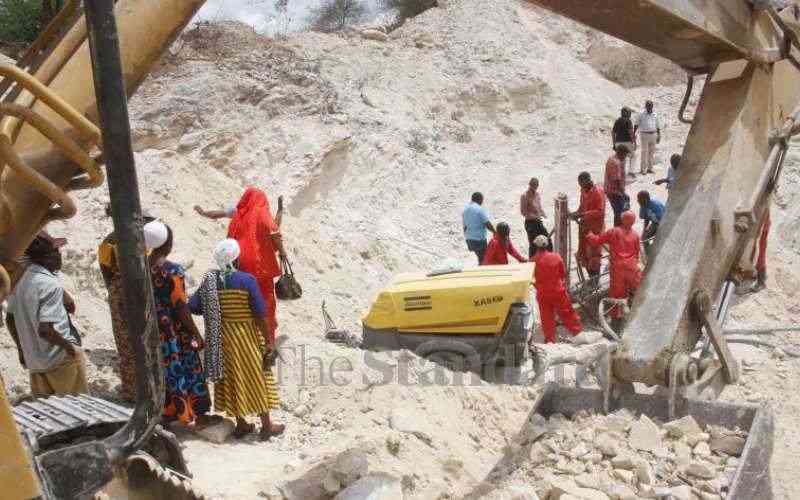For three years in a row, Margaret Mwake’s roughly one-acre farm has not given her any meaningful yield. Even as rain has pounded other parts of Kenya in the last few months, it has barely drizzled in Rukanga, Kasigau Ward, where Margaret hails from. Consequently, her locality has been hit by a drought that can easily degenerate into famine.
The National Drought Management Authority (NDMA) has already declared that Taita Taveta residents like Margaret are among 4.1 million Kenyans threatened by starvation.
In other counties, drought empties farms and dinner tables then stops there, which is bad enough. But in Taita Taveta, drought does more. For Kasighau residents like Margaret and her neighbour Ruphence Malemba, drought increases their encounter with elephants. During drought, these mammalian giants routinely invade their farms in search of food and water.
Climate change-induced drought pushes these elephants from their natural habitats in the Tsavo Parks into human habitations in search of food and water. For three consecutive years, these elephants have destroyed crops in Kasigau’s farms in their desperate search for food and water.
Unfortunately for them, even humans in Kasigau have a problem finding water. Residents mostly consume water piped in from the nearby Mt Kasigau. Erratic rainfall has drastically reduced this water. Consequently, many residents rely almost entirely on water that is ferried in by trucks. These truck trips are irregular, which leaves them in a vulnerable situation.
Margaret is a single mother of four, all primary school dropouts and jobless. Her two daughters already have a child each and are single mothers like her. Just like many young men in Kasigau, her two sons have fallen into occasional drunkenness. Alcoholism in Taita Taveta is such a pressing problem that in 2020, the County Commissioner’s office revealed that rampant alcoholism was a major driver of sexual abuse cases.
Against this backdrop, Margaret and Ruphence ventured into Taita Taveta’s mining territory in search of casual jobs that would help them fend for their families.
Kasigau, where the two women hail from, is renowned for its gemstones. The Mozambique belt passes through Kasigau, Taita Hills, Mwatate and Kuranze, all in Taita Taveta County. This belt hosts more than 40 high value gemstones. They include ruby, tsavorite, garnets, tourmalines, sapphire, amethyst, peridot, iolite, spinel, rhodolites and kyanites.
Over the last few decades, these gemstones have made billions for established gemstone firms like one belonging to former Machakos Senator and current United Democratic Alliance (UDA) Chairman Johnston Muthama. Although his Firm, Rockland Kenya Limited, has employed dozens and positively impacted hundreds indirectly, the vast majority of Kasighau residents are not in the value chain of such large scale mining operations. They have to depend on smaller mining firms and the numerous artisanal miners in the county.
Margaret and Ruphence eventually found casual jobs in a mine owned by a well-known female miner. The mine’s work conditions were quite demanding. Workers were provided with food only once a day. They lived on site in polythene tents.
The two and dozens of other women toiled under the hot sun for long hours daily using ordinary hoes and axes. Making progress with this simple equipment was a herculean task, but they soldiered on. Their duty was singular – to keep digging and unearthing gemstones.
After several weeks of digging without pay, scores of female diggers resorted to hiding a few gemstones so that they could sell them and pay themselves.
They were desperate for some payment so that they could send some money back home to their children.
Over the last few decades, these gemstones have made billions for established gemstone firms like one belonging to former Machakos Senator and current United Democratic Alliance (UDA) Chairman Johnston Muthama. Although his Firm, Rockland Kenya Limited, has employed dozens and positively impacted hundreds indirectly, the vast majority of Kasighau residents are not in the value chain of such large scale mining operations. They have to depend on smaller mining firms and the numerous artisanal miners in the county.
Margaret and Ruphence eventually found casual jobs in a mine owned by a well-known female miner. The mine’s work conditions were quite demanding. Workers were provided with food only once a day. They lived on site in polythene tents.
The two and dozens of other women toiled under the hot sun for long hours daily using ordinary hoes and axes. Making progress with this simple equipment was a herculean task, but they soldiered on. Their duty was singular – to keep digging and unearthing gemstones.
After several weeks of digging without pay, scores of female diggers resorted to hiding a few gemstones so that they could sell them and pay themselves.
They were desperate for some payment so that they could send some money back home to their children.
Source ~ The Standard, By David John Bwakali

